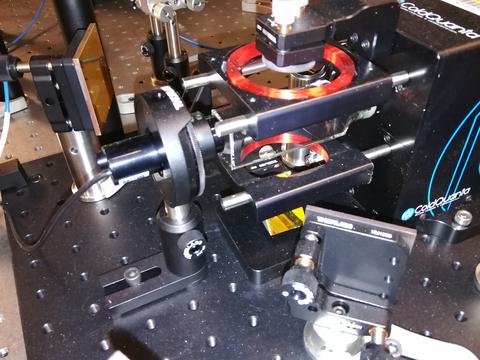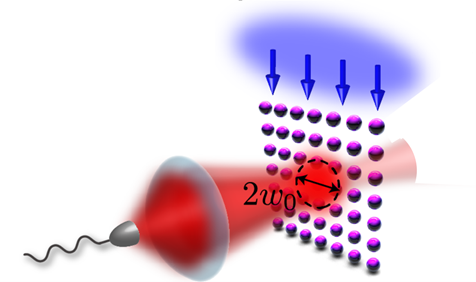Quantum memory and Repeaters
Both classical and quantum long-distance networks require repeaters to mitigate exponential loss of the signal with distance. Because unknown quantum states cannot be copied with perfect fidelity and because measurement destroys quantum properties such as entanglement, quantum repeaters cannot operate on the same physical principles as classical ones. Theoretical research shows that quantum repeaters can be built with either quantum memory or with the help of exotic quantum states such as graph states. Proof of principle experiments have been successful.
However, the experimental implementation of scalable quantum memories and exotic quantum states is still difficult, and fundamental research is ongoing. The main challenge in developing good quantum memories is the efficient coupling of photonic qubits into and out of the material systems used for quantum information storage. NIST scientists are actively developing quantum memories using two different material systems: ions and neutral atoms.
Practical quantum repeaters based on trapped ions
(QNGC grand challenge project)
Quantum memory lifetimes of longer than 30 minutes can be realized in trapped ions. In addition, low (< 10-3) errors per entanglement swapping operation can be reached, which is crucial for implementing efficient quantum repeaters. The remaining challenge is to couple ions efficiently to telecom photons to realize entanglement distribution between repeater stations separated by approximately 30 km. We plan to efficiently couple memory ions to photons in the telecom range through intermediate ions that are suitable for transduction. Efficient coupling of ions to photons in a miniaturized high quality fiber cavity may eventually enable entanglement over terrestrial (1000s of km) distances that can persist for tens of minutes.

PI contacts: Andrew Wilson, Dietrich Leibfried, Daniel Slichter.
Technical Readiness Level: 1

Electromagnetically Induced Transparency Quantum Memory
We study both warm and cold quantum memory based on electromagnetically induced transparency (EIT) in cesium atomic ensembles. Using EIT, we have stored photons in warm ensembles for several µs before being released on demand. We are currently implementing cold ensembles via a magneto-optical trap (MOT) to achieve longer storage times. Noise is a big challenge for EIT because a very strong pump beam is aligned (spatially and spectrally) with the single photon beam. We have developed techniques to remove the strong beam while preserving the single photon beam. We have used our EIT quantum memory to implement a highly accurate spectrometer.
PI contacts: Lijun Ma, Oliver Slattery, Xiao Tang
Notable Publications:
L. Ma, O. Slattery, and X. Tang, Optical quantum memory based on electromagnetically induced transparency, Journal of Optics, 19, 043001 (2017)
L. Ma, O. Slattery, and X. Tang, Noise Reduction in Optically Controlled Quantum Memory, Modern Physics Letters B, 32, 1830001 (2018) https://doi.org/10.1142/S0217984918300016
L. Ma, O. Slattery, and X. Tang, Ultra-high spectral resolution spectrometer for single photon source characterization, Quantum Information Science, Sensing and Computation X, 10660, 1066006 Orlando, FL, (2018) https://doi.org/10.1117/12.2303836
L. Ma, X. Tang, and O. Slattery, Optical quantum memory and its applications in quantum communication systems, J. Res. Natl. Inst. Stand. Technol., 125, 125002 (2020) https://doi.org/10.6028/jres.125.002
S. Bhushan, O. Slattery, X. Tang, and L. Ma, Terahertz Electromagnetically Induced Transparency in Cesium Atoms, Frontier in Optics, virtual conference (2020)
Patent: L. Ma, O. Slattery and X. Tang. Direct absolute spectrometer for direct absolute spectrometry. US Patent 10641655 B2, May 05, 2020.
Technology Readiness Level: 3 Proof-of-Concept Demonstrated, Analytically and/or Experimentally.

Theory of atomic ensemble-based quantum memory and repeaters
We work on the theory of interacting photons in Rydberg-EIT media and on using these systems for quantum networking. We also theoretically investigate ensemble-based quantum memories. In particular, we find that arrays of neutral atoms can significantly improve the interfacing of the memory with light in comparison to conventional disordered ensembles. This work is done in collaboration with NIST and external experimentalists and theorists.
PI contact: Alexey Gorshkov
Notable Publications:
A.V. Gorshkov, A. André, M. Fleischhauer, A. S. Sørensen, and M. D. Lukin, Universal Approach to Optimal Photon Storage in Atomic Media., Physical Review Letters, 98, 123601 (2007) https://doi.org/10.1103/PhysRevLett.98.123601
A.V. Gorshkov, J. Otterbach, M. Fleischhauer, T. Pohl, and M. D. Lukin, Photon-Photon Interactions via Rydberg Blockade, Physical Review Letters, 107, 133602 (2011) https://doi.org/10.1103/PhysRevLett.107.133602
T. Peyronel, O. Firstenberg, Q.-Y. Liang, S. Hofferberth, A. V. Gorshkov, T. Pohl, M. D. Lukin, and V. Vuletić, Quantum Nonlinear Optics with Single Photons Enabled by Strongly Interacting Atoms, Nature, 488, 57 (2012) https://doi.org/10.1038/nature11361
O. Firstenberg, T. Peyronel, Q.-Y. Liang, A. V. Gorshkov, M. D. Lukin, and V. Vuletić, Attractive Photons in a Quantum Nonlinear Medium, Nature, 502, 71 (2013) https://doi.org/10.1038/nature12512
D.P. Ornelas-Huerta, A.N. Craddock, E.A. Goldschmidt, A.J. Hachtel, Y. Wang, P. Bienias, A.V. Gorshkov, S.L. Rolston, J.V. Porto, On-demand indistinguishable single photons from an efficient and pure source based on a Rydberg ensemble, Optica 7, 813-819 (2020) https://doi.org/10.1364/OPTICA.391485
C. Murray, I. Mirgorodskiy, C. Tresp, C. Braun, A. Paris-Mandoki, A. Gorshkov, S. Hofferberth, and T. Pohl, Photon Subtraction by Many-Body Decoherence, Physical Review Letters, 120, 113601 (2018) https://doi.org/10.1103/PhysRevLett.120.113601
O. Katz, E. Reches, R. Shaham, A. V. Gorshkov, O. Firstenberg, “Optical quantum memory with optically inaccessible noble-gas spins,” arXiv:2007.08770 [quant-ph] (2020)
Technology Readiness Level: 1
Contacts
-
(301) 975-5887
-
(301) 975-4281
-
(301) 975-8473

